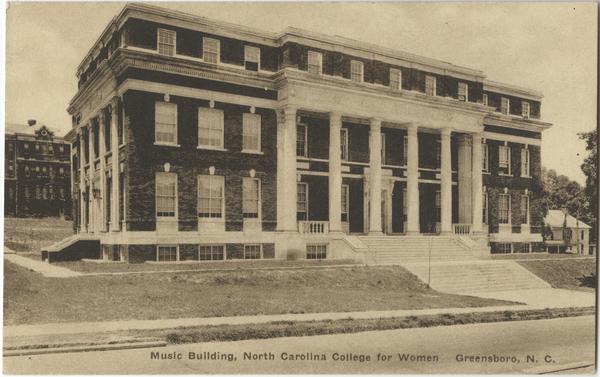The University of North Carolina at Greensboro (UNCG) has one of the most beautiful campuses in the state, in most part because of the efforts of past college president, Julius Foust and architect Harry Barton. Although Barton had many important commissions throughout North Carolina, it was perhaps his relationship with Julius Foust, which would provide some of his most important commissions and one of the most prolific periods in his career.
During the 1920s, the small women’s college had an unprecedented expansion. With the student body almost doubling in size and the faculty growing to meet the demands of extra courses, Foust began planning an enlargement of the campus, including residence halls, classroom buildings, and a large auditorium. In Barton, he saw an architect who could make his vision of the school into a reality. Foust commissioned the architect to design seventeen of the buildings constructed on campus during this state-wide building campaign.
Although Harry Barton was a native of Philadelphia, he became an important part of the architectural legacy of Greensboro. He earned a degree in architecture from George Washington University and did postgraduate study at the Beaux-Arts Institute of Design. After graduation he worked in both Philadelphia and Washington, D.C., before moving with his wife to Greensboro in 1912. Barton believed that Greensboro was a “city with a future,” benefiting from being a pivotal part of the prosperous Piedmont region of the state. Quickly gaining his own clientele of notable Greensboro businessmen, he received the lucrative commission for the Guilford County Courthouse (1918-1920), as well as many other courthouses, schools, churches, governmental buildings, and schools. Incorporating Neo-Classic, Gothic, Art Deco, Tudor, and Georgian architectural styles into his designs, Barton proved that he was a versatile and talented young architect.
Foust trusted Barton to form the newer architectural design of the campus. While most of the original buildings on campus were of the Romanesque style, Barton chose the more popular classical revival design. Many of Barton’s other architectural projects focused on residence halls – not surprising with the growth in student population, but buildings that would meet the physical and academic needs of the students were also prioritized. An Outdoor Gymnasium was an early structure that served as the primary physical education structure until the completion of the Rosenthal Gymnasium, also designed by Barton, which was completed in 1925.
The building campaign, which lasted almost the entire decade, included the Shaw Residence Hall (1919), Gray Residence Hall (1921), Outdoor Gymnasium (1922), Hinshaw Residence Hall (1922), Bailey Residence Hall (1922), the President’s Residence (1923), Cotten Residence Hall (1922), Coit Residence Hall (1923), Jamison Residence Hall (1923), Brown Music Building (1925), Physical Education Building (1925), Curry Building (1926), [Aycock] Auditorium (1927), Mary Foust Residence Hall (1927), Guilford Residence Hall (1928), the Home Economics Building (1928). While these structures were being completed, Foust also had College Avenue paved in 1928, further modernizing the look of the campus.
Barton became one of the most notable architects in the state. He was one of the first licensed architects in North Carolina as well as a member of the National American Institute of Architects, the North Carolina Chapter of the American Institute of Architects, and the State Board of Examiners in Architecture. He was also a well-respected member of the community, heavily involved in the Presbyterian Church, as well as the Kiwanis Club and the Masons. But one of his greatest legacies is his contribution to the beautiful UNCG campus.
By Kathelene McCarty Smith



